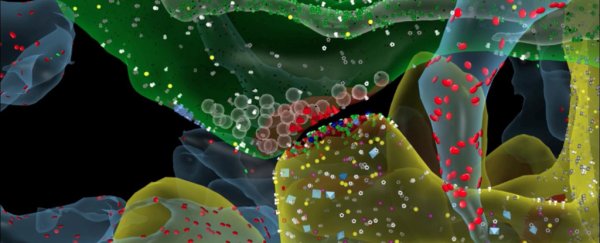The human brain's memory capacity may be as much as 10 times larger than previously thought, according to a new study by scientists in California that looked at how hippocampal neurons in the brain function with low energy but high computational power.
"This is a real bombshell in the field of neuroscience," said Terry Sejnowski from the Salk Institute for Biological Studies. "Our new measurements of the brain's memory capacity increase conservative estimates by a factor of 10 to at least a petabyte, in the same ballpark as the World Wide Web."
The researchers built a 3D reconstruction of rat hippocampus tissue – the memory centre of the brain – and in doing so, discovered something strange. Synapses, the junctions that form between neurons, were being duplicated in about 10 percent of cases.
To measure the differences between these duplicate synapses, Sejnowski's team reconstructed the connectivity, shapes, volumes, and surface area of the rat brain tissue at a nano-molecular level, using advanced microscopy and computational algorithms.
"We were amazed to find that the difference in the sizes of the pairs of synapses were very small, on average, only about 8 percent different in size," said Tom Bartol, one of the scientists. "No one thought it would be such a small difference. This was a curveball from nature."
The revelation that synapses can vary in size by increments as subtle as 8 percent suggests that there may be as many as 26 categories of sizes of synapses, rather than just a few, as scientists previously believed. According to the researchers, this extra complexity in synaptic dimensions translates to a huge boost in the brain's potential memory capacity.
"This is roughly an order of magnitude of precision more than anyone has ever imagined," said Sejnowski. "The implications of what we found are far-reaching. Hidden under the apparent chaos and messiness of the brain is an underlying precision to the size and shapes of synapses that was hidden from us."
The researchers' calculations suggest that synapses also change their size and ability depending on neural transmissions. About 1,500 transmissions provoke a change in small synapses (taking about 20 minutes), while a couple hundred (1 to 2 minutes) will change large synapses.
"This means that every 2 or 20 minutes, your synapses are going up or down to the next size," said Bartol. "The synapses are adjusting themselves according to the signals they receive."
The findings, reported in eLIFE, could lead to advancements in computing, with ultra-precise and energy-efficient machines employing deep learning and neural networking techniques.
"This trick of the brain absolutely points to a way to design better computers," said Sejnowski. "Using probabilistic transmission turns out to be as accurate and require much less energy for both computers and brains."
You can find out more about the research in the video below:

